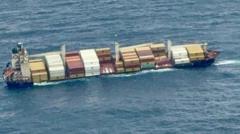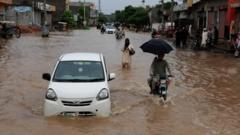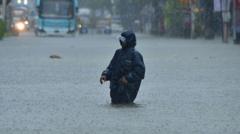The coastal waters of Kerala are under threat after a Liberian-flagged cargo ship sank off Kochi, leaking hazardous materials that could have catastrophic effects on both the environment and local communities. The incident occurred on Sunday, with the vessel, MSC ELSA 3, capsizing approximately 38 nautical miles from shore due to a flooding compartment.
All 24 crew members were successfully rescued, but officials are now grappling with the fallout of the incident as containers, some containing hazardous cargo, have started to wash up along the state's biodiverse coastline, renowned for its tourism appeal. Local authorities have raised alarms, fearing the repercussions of spilled oil, fuel, and chemicals on the health of both the community and marine ecosystems.
“An alert has been sounded across the coastal belt as the oil slick poses a potential threat,” stated the chief minister's office. Local residents are advised to stay clear of any containers or oily substances that may reach the shore. Fishermen have been instructed to maintain a safe distance from the wrecked vessel, as the threats from the chemicals it was carrying could instigate dangerous reactions.
To combat the spill, the Indian Coast Guard has stepped up its response efforts. They have dispatched a pollution control vessel equipped with necessary equipment and an aircraft with specialized oil spill detection systems to monitor the affected areas. Reports indicate that the vessel was not solely carrying hazardous cargo — it also held a significant volume of oil, including 84.44 metric tonnes of diesel and over 367 metric tonnes of furnace oil.
The incident highlights not only the dangers associated with maritime shipping but also the urgent need for effective environmental safeguards to prevent such disasters in the future, underscoring the balance that must be struck between economic activities and ecological stewardship in sensitive coastal regions.
All 24 crew members were successfully rescued, but officials are now grappling with the fallout of the incident as containers, some containing hazardous cargo, have started to wash up along the state's biodiverse coastline, renowned for its tourism appeal. Local authorities have raised alarms, fearing the repercussions of spilled oil, fuel, and chemicals on the health of both the community and marine ecosystems.
“An alert has been sounded across the coastal belt as the oil slick poses a potential threat,” stated the chief minister's office. Local residents are advised to stay clear of any containers or oily substances that may reach the shore. Fishermen have been instructed to maintain a safe distance from the wrecked vessel, as the threats from the chemicals it was carrying could instigate dangerous reactions.
To combat the spill, the Indian Coast Guard has stepped up its response efforts. They have dispatched a pollution control vessel equipped with necessary equipment and an aircraft with specialized oil spill detection systems to monitor the affected areas. Reports indicate that the vessel was not solely carrying hazardous cargo — it also held a significant volume of oil, including 84.44 metric tonnes of diesel and over 367 metric tonnes of furnace oil.
The incident highlights not only the dangers associated with maritime shipping but also the urgent need for effective environmental safeguards to prevent such disasters in the future, underscoring the balance that must be struck between economic activities and ecological stewardship in sensitive coastal regions.




















